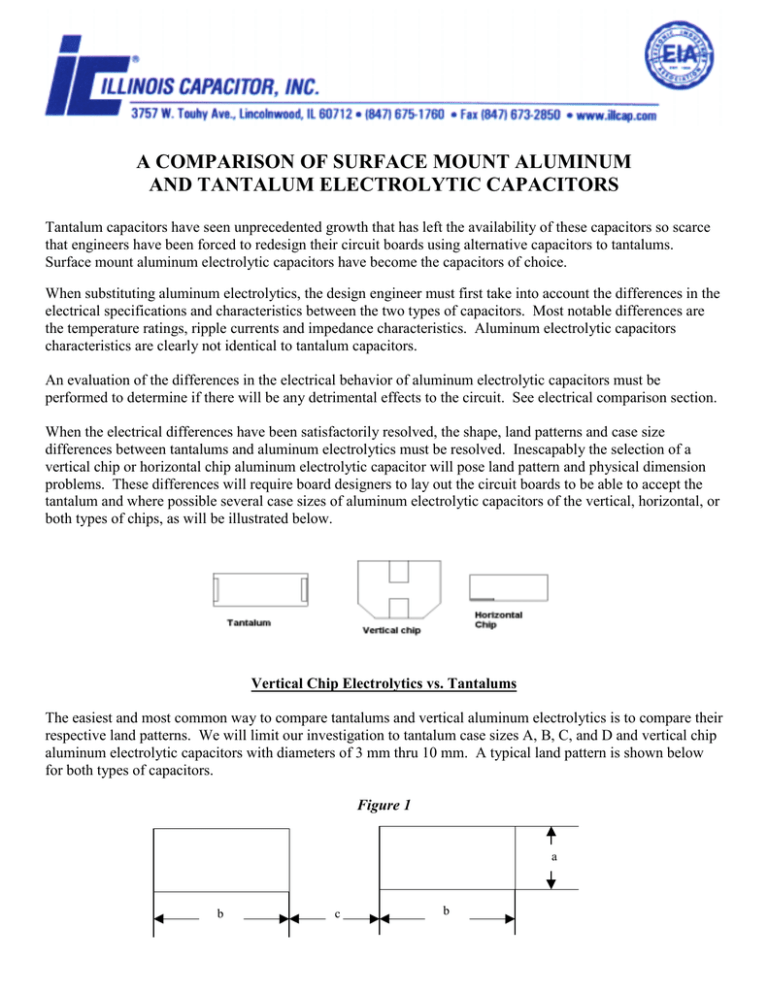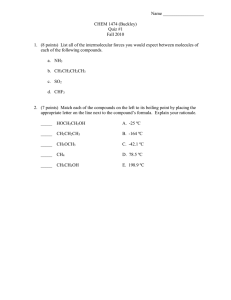a comparison of surface mount aluminum
advertisement

A COMPARISON OF SURFACE MOUNT ALUMINUM AND TANTALUM ELECTROLYTIC CAPACITORS Tantalum capacitors have seen unprecedented growth that has left the availability of these capacitors so scarce that engineers have been forced to redesign their circuit boards using alternative capacitors to tantalums. Surface mount aluminum electrolytic capacitors have become the capacitors of choice. When substituting aluminum electrolytics, the design engineer must first take into account the differences in the electrical specifications and characteristics between the two types of capacitors. Most notable differences are the temperature ratings, ripple currents and impedance characteristics. Aluminum electrolytic capacitors characteristics are clearly not identical to tantalum capacitors. An evaluation of the differences in the electrical behavior of aluminum electrolytic capacitors must be performed to determine if there will be any detrimental effects to the circuit. See electrical comparison section. When the electrical differences have been satisfactorily resolved, the shape, land patterns and case size differences between tantalums and aluminum electrolytics must be resolved. Inescapably the selection of a vertical chip or horizontal chip aluminum electrolytic capacitor will pose land pattern and physical dimension problems. These differences will require board designers to lay out the circuit boards to be able to accept the tantalum and where possible several case sizes of aluminum electrolytic capacitors of the vertical, horizontal, or both types of chips, as will be illustrated below. Vertical Chip Electrolytics vs. Tantalums The easiest and most common way to compare tantalums and vertical aluminum electrolytics is to compare their respective land patterns. We will limit our investigation to tantalum case sizes A, B, C, and D and vertical chip aluminum electrolytic capacitors with diameters of 3 mm thru 10 mm. A typical land pattern is shown below for both types of capacitors. Figure 1 a b c b A COMPARISON OF SURFACE MOUNT ALUMINUM AND TANTALUM ELECTROLYTIC CAPACITORS . . . Table 1 shows the comparison of the land patterns of tantalum capacitors to the vertical chip aluminum electrolytic capacitors. Table 1 Land Pattern Dimension a b c TANTALUMS Case Code A B C D 1.4 1.7 2.6 2.8 2.0 2.1 2.5 2.8 1.2 1.4 2.8 4.3 ALUMINUM ELECTROLYTICS Diameters 3 4 5 6.3 8 10 1.7 1.8 1.8 1.8 2.1 2.5 2.2 2.6 3.0 3.5 4.1 4.4 .8 1.0 1.4 2.1 2.8 4.3 Table 2 lists the recommended vertical chip aluminum electrolytic alternatives for each tantalum capacitor case sizes that are closest matches of the land patterns. Case Code A B C D Table 2 Aluminum Electrolytic Substitute 3, 4, 5 4, 5, 6.3 4, 5, 6.3 5, 6.3, 8 10 With the problem of land pattern matching resolved, the designer must now address what ultimately is the biggest problem, matching case dimensions. Table 3 below compares the case dimensions of tantalums and dimensions of vertical chip aluminum electrolytics. L (H) W (W) Table 3 TANTALUM ALUMINUM ELECTROLYTICS Case Code Diameter A B C D 3 4 5 6.3 8 10 3.2 3.5 6.0 7.3 3.9 5 6 7.3 9 11 1.6 2.8 3.2 4.3 3.3 4.3 5.3 6.6 8.3 10.3 Where L and W are the length and width of the tantalum chip, and H and W are the pad base length and width dimensions of an aluminum electrolytic. Figure 2 W W Tantalum Chip Aluminum Electrolytic L 5 H A COMPARISON OF SURFACE MOUNT ALUMINUM AND TANTALUM ELECTROLYTIC CAPACITORS . . . Figure 2 clearly illustrates the differences in the shape between the tantalum and vertical chip aluminum electrolytic and the difficulty in board layout these differences pose to designers. It is evident that no aluminum electrolytic can be used as a drop-in replacement for a tantalum capacitor unless there is 2 to 3 mm of free space around each tantalum capacitor’s location on the circuit board, which is what would be needed to use a vertical chip aluminum electrolytic instead of a tantalum capacitor. To this point we have only addressed two of the three dimensions affecting the selection of a capacitor. The third and last is, of course, height. This is the easiest problem to address and resolve. In height limited applications, low profile aluminum electrolytics should be used. In all other applications, use standard case heights. Horizontal Chip Electrolytic vs. Tantalum Horizontal chip aluminum electrolytics are a relatively new type of capacitor. Their advantage over vertical chip aluminum electrolytics is its low height and vibration tolerance. The shape of these capacitors is similar to tantalums except the lead orientation and location is different. Figure 3 illustrates the differences in the shapes and lead locations of these capacitors. Figure 3 Just like vertical chip electrolytics, the differences in electrical parameters must be evaluated before selecting a horizontal chip electrolytic as an alternative to tantalum capacitors. Once the electrical parameters have been resolved, the land patterns and physical dimensions must be addressed. As before, a typical land pattern for the capacitors is illustrated below. 5 A COMPARISON OF SURFACE MOUNT ALUMINUM AND TANTALUM ELECTROLYTIC CAPACITORS . . . Table 4 compares the land patterns for horizontal chip electrolytics and tantalums. Dimension a b c A 1.4 2.0 1.2 Table 4 TANTALUMS Case Code B C D 1.7 2.6 2.8 2.1 2.5 2.8 1.4 2.8 4.3 HORIZONTAL CHIP Case Code 3A 3B 4A 4B 3.0 3.0 3.3 3.3 1.2 1.2 1.2 1.2 2.2 2.2 3.2 3.2 Table 5 shows the recommended horizontal chip alternatives to tantalums that will have comparable land pattern requirements. Table 5 Tantalum Case Code A B C D Horizontal Chip Alternatives 3A, 3B 3A, 3B 3A, 3B, 4A, 4B 4A, 4B It is important to note that horizontal chips need to have land patterns where the solder pads will extend beyond the body width of the chips or else the leads will not be solderable. See Figure 3. The next and most significant problem is the physical dimensions of the capacitor types. Table 6 is a comparison of the physical dimensions of the capacitors. L W Table 6 TANTALUMS HORIZONTAL CHIPS A B C D 3A 3B 4A 4B 3.2 3.5 6.0 7.3 3.6 3.6 4.6 4.6 1.6 2.8 3.2 4.3 6.3 9.3 7.1 10.1 It is evident the width of any horizontal chip capacitor exceeds the width of any tantalum capacitor. Just like vertical aluminum electrolytics, the horizontal aluminum electrolytic capacitors cannot be used as a drop-in replacement for tantalums. Secondly, to mount horizontal electrolytics , the lead location for these parts is not located along the length of the body but is located along the width and at one end of the capacitor, as shown in Figure 3. This difference clearly requires a redesign of the layout of the circuit board. Until such time that tantalum capacitors become more readily available, the circuit designer should evaluate aluminum electrolytic capacitors in their designs and where possible lay out their circuit boards to accommodate both aluminum and tantalum capacitors. 5 A COMPARISON OF SURFACE MOUNT ALUMINUM AND TANTALUM ELECTROLYTIC CAPACITORS . . . Electrical Comparison Electrically solid tantalum capacitors have several performance advantages over aluminum electrolytic capacitors, which has made them the preferred capacitor for surface mount applications. Among the advantages are: ! ! ! ! ! ! ! ! Small size No liquid electrolyte Superior temperature stability Wider operating temperature range (up to +125°C) Long storage (shelf) life Larger reverse voltage tolerance Low dissipation factor Self healing Aluminum electrolytic capacitors do have several advantages over tantalum capacitors. Most prominently: ! ! ! ! ! Lower cost Higher availability Shorter production lead times Low leakage current Higher voltage range (up to 400 VDC) Some of the most prominent electrical performance differences between tantalums and aluminum electrolytics that should be resolved before substituting an aluminum electrolytic for a tantalum capacitor are: ! ! ! ! Aluminum electrolytic’s higher dissipation factors/ESR, which in turn reduces their ripple current capabilities. Aluminum electrolytic’s larger capacitance change over temperature. Electrolytics can change up to six times more than tantalums. Aluminum electrolytic’s capacitance change over frequency. Aluminum electrolytic’s changes over time -- up 20% after 2,000 hours for aluminum electrolytics. Aluminum electrolytic capacitors have been making tremendous strides in improving their characteristics to be more compatible with tantalum specifications, most notably the reduction in physical size, stability over frequency and lower leakage current. These improvements can be seen in the high frequency low ESR/impedance aluminum electrolytic capacitors and in the low leakage current specifications in each capacitor series. Temperature ratings of 125°µC for aluminum electrolytics are now available. Mark Gebbia Applications Engineer ILLINOIS CAPACITOR, INC. 5





